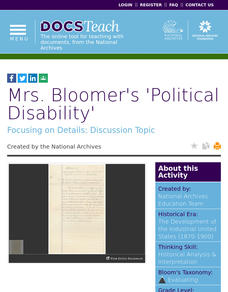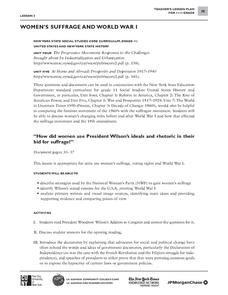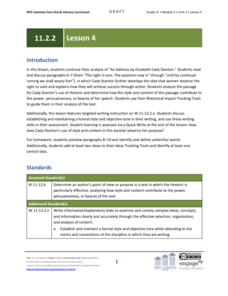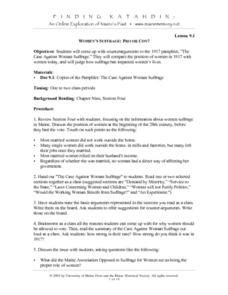DocsTeach
Mrs. Bloomer's 'Political Disability'
It's hard to believe that women had to argue for the right to vote a mere 100 years ago. Today, young historians can examine their case left behind in primary sources. Using a letter from a woman who claimed she should be able to vote...
National Woman's History Museum
Ida B. Wells: Suffragist and Anti-Lynching Activist
Suffragette, investigative journalist, and civil rights activist Ida B. Wells is the focus of a lesson that has young historians study the work of this amazing woman. Scholars watch a video biography of Wells, read the text of her speech...
Curated OER
Women’s Suffrage
Students examine several aspects of the Women's Suffrage Movement. In this women's rights lesson, students explore several primary and secondary sources regarding the events of the movement, opposition to the movement, and the effects of...
Curated OER
The Women's Suffrage Movement Signature Debacle
Students examine the Women's Suffrage Movement in Nebraska. In this women's rights lesson, students explore primary and secondary sources regarding suffrage in the state and obstacles that women in the state faced when it came to casting...
Curated OER
Women: Stride Toward Freedom
Students read facts about women'ts suffrage and research topics related to women's rights. Optional films for viewing and books to read.
Curated OER
Why Vote?
Students design a ballot slip for student voting. They create a slogan and political brochure.
Curated OER
Emmeline Pankhurst, Why We Are Militant
Emmeline Pankhurst wrote Why We Are Militant in order to explain the plight of women during the time of suffrage. Learners read an excerpt from her work and answer one critical thinking question.
Curated OER
Universal Suffrage
Young scholars examine suffrage. They participate in a classroom activity in which some students get to vote and others do not get to participate. Young scholars discuss how they felt and how it wasn't fair. They write a one page essay...
PBS
Elizabeth Cady Stanton: Orator, Author, and Activist
Have you ever felt like your opinion doesn't count? Scholars research and analyze the impact Elizabeth Cady Stanton had on women's rights. Primary and secondary sources as well as video clips give individuals a clear picture of Stanton's...
Curated OER
Women's Right To Vote
Fifth graders explore the history of women's right to vote and identify two of the leaders of the suffrage movement, Alice Paul and Lucy Burns. After completing readings and discussions, they write an article for the newspaper about...
National Endowment for the Humanities
Cultural Change
High schoolers research the passage of the 19th Amendment as an illustration of the mutual influence between political ideas and cultural attitudes. They also read the Seneca Falls Declaration and explore the cultural shifts it both...
Curated OER
Role Model Medal
Students investigate positive female role models. In this Women's History Month lesson, students read the book Mama Went to Jail for the Vote and think about how the character was a role model for other women. Students brainstorm a woman...
Curated OER
Just a Spoonful of Rights Makes the Responsibility Go 'Round
Students explore the concept of philanthropy. In this service learning lesson plan, students define rights and responsibilities. Students discuss the role of philanthropy in contributing to the common good. They also review historical...
Curated OER
Women Today: An Editorial
Young scholars complete Internet research to write an editorial about a topic relating to the women's rights movement and the issues presently surrounding women's rights in America and around the world.
Jane Addams Project
Woman Suffrage
Suffragettes, suffragists, and anti-suffragists. A two-day, richly detailed lesson plan has young historians investigate the twentieth-century suffrage movement. Groups examine primary and secondary source materials about Jane Addams and...
City University of New York
Woman's Suffrage and World War I
How did women use President Wilson's ideals and rhetoric in their bid for suffrage? To answer this essential question, class groups analyze primary written documents and visual images.
EngageNY
Grade 11 ELA Module 2: Unit 2, Lesson 4
How does style contribute to the power and persuasiveness of a speech? With the question in mind, scholars continue reading "An Address by Elizabeth Cady Stanton." They complete a Rhetorical Impact Tracking Tool to guide them in their...
Curated OER
Suffragettes
Students investigate peer pressure by discussing women's suffrage. In this Women's rights lesson, students explore the history of voting in the United States and when women were finally allowed to do so. Students create a poster in order...
Curated OER
Democracy Sense
Students define democracy and distinguish representative from direct or pure democracy. Then, with the focus on representative government, students will discuss and trace voting patterns in the United States.
Curated OER
Votes for Women
In this 20th century events learning exercise, students read about the voting rights earned by women in the 20th century. Students learn the terms suffrage and suffragettes. Students answer 4 questions about the information.
Curated OER
Suffragettes Activities
In this suffragettes worksheet, students match the words about suffrage with their meanings. Students list 8 methods the suffragettes used and one peaceful method they could have used.
Curated OER
WOMEN'S SUFFRAGE: PRO OR CON?
Students come up with counterarguments to the 1917 pamphlet, "The Case Against Woman Suffrage." They compare the position of women in 1917 with women today, and judge how suffrage has impacted women's lives. They write a personal...
Curated OER
Voting and the U.S. Constitution (Past, Present, and Future), Part 2
Students analyze and discuss the 19th Amendment, and read the document, Why Women Want to Vote. Students illustrate statements from the handbill, then conduct a play about women's suffrage.
Education World
Every Day Edit - Women Get the Vote
In this everyday editing worksheet, students correct grammatical mistakes in a short paragraph about suffrage. The errors range from punctuation, capitalization, grammar, and spelling.

























